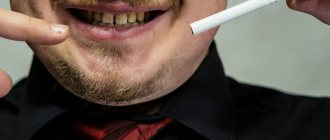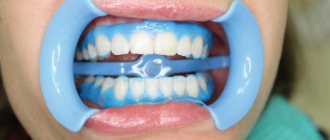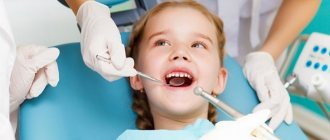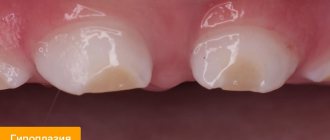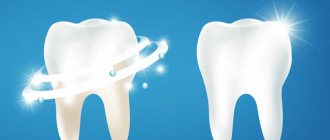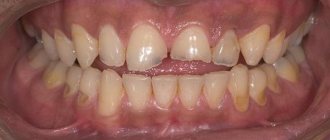Charge for regular drinks
It would seem that there is nothing reprehensible in a cup of coffee or tea in the morning, afternoon and evening. Most people have long been accustomed to these liquids, although they appeared in our culture, frankly speaking, relatively recently. One way or another, getting too carried away with them can also lead to yellow teeth. By the way, the type and color of tea does not really matter here. For example, the majority today do not even know how to choose the right green tea, opting for advertised, unnatural varieties with an abundance of artificial coloring substances. Suffice it to say that the popular so-called “milk oolong” is a chemical that the Chinese themselves will never drink.
Causes.
Teeth turn yellow
for various reasons - obvious and not so obvious.
The obvious ones
are
smoking and excessive consumption of tea and coffee. From these bad habits, first a light yellowish plaque forms on the teeth, and then a hard brown one. It is usually removed in the dental office as part of professional oral hygiene. The same reasons include traces of food dyes - beets, carrots, wine and artificial colors that I add to food and drinks today. The dentist will also tell you how to deal with this plaque.
There are also little-known ones
reasons why
teeth begin to turn yellow.
There are several of them.
- Their tap water. If you live in a region where the water is oversaturated with iron or other minerals, this will sooner or later affect the color of the enamel. To prevent your teeth from turning yellow
, simply filter and purify the water. - Sometimes teeth turn yellow
from medications. Most often from antibiotics. This process is especially noticeable in people taking tetracycline for a long time. However, other medications can cause enamel discoloration. - Yellowed teeth
can also be a symptom of heavy metal vapor poisoning. This cause is very dangerous, and urgent measures must be taken to exclude pathology. - Teeth can turn yellow
simply due to excessive consumption of sugar. The solution is to give up sweets. - The color of enamel can change as a reaction to disordered diets. Teeth simply cannot help but react to the lack of certain minerals and trace elements they need. In most cases, refusing to eat provides this.
- Teeth turn yellow
from injuries inside the tooth. Especially if they are not noticeable at first glance and measures are not taken in time. - An inevitable cause of tooth discoloration is age. The color of dentin changes synchronously with the aging of the body and this must be accepted as inevitable.
- Teeth usually turn yellow
due to diseases of the kidneys, blood, and some infections. In this case, it is necessary to treat not the consequence - yellow teeth, but the cause of the pathology. - Yellow spots may appear on the teeth of people wearing braces. The color of the enamel changes exactly in the place where the fastenings are located.
- The main and most common cause of yellowing teeth is irregular and poor-quality individual oral hygiene. You need to equip yourself with toothpaste, brush and floss at least twice a day. Three is better.
Which cannot be the reason for the appearance of yellow plaque on teeth.
There are very common misconceptions that need to be dispelled. Teeth do not turn yellow:
- from hot and cold
- from sinusitis
- from herbal decoctions
- from lipstick
- from apples.
What to do with yellow teeth
Thus, we counted plenty of factors. The question remains - what to do about it? Today, technology makes it possible to solve the problem of yellow teeth quickly, painlessly and effectively. At Dentik we use the innovative ZOOM Advanced Power whitening system. It allows, using calcium phosphate and exposure to a safe diode lamp, to lighten teeth by several tones, without harming their health and guaranteeing a long-term effect. The specialist will also advise you on how to properly care for your whitened teeth and give you a set of home care products.
Contact our clinic and take advantage of this great opportunity! A dazzling smile is simple and safe!
Causes of yellow plaque
Medical scientists have proven that in many cases the shade of bone tissue is genetically programmed even at conception. To be honest, Mother Nature does not give dazzling snow-white incisors. Shade options can range from blue and gray to beige and yellowish. Of course, if teeth turn yellow “before our eyes,” this cannot be ignored; this must be dealt with in order to return the teeth to their natural color.
The primary and main factor of pathology is the patient’s lifestyle. Experts are confident that after its change there will definitely be some positive changes. If we talk about external stains, they usually appear on the top layer of enamel. And although enamel stains easily, especially damaged enamel, these stains can be removed and can be professionally corrected. Internal stains affect dentin, that is, the main tissue of the unit. In this case, removal is also possible, but it is difficult.
It also happens that fluoride, which is beneficial for teeth and strengthens crowns, forms weak white stripes or brown spots if there is too much of it. This problem is typical for regions where high doses of natural fluoride are found in drinking water. Those who take water from wells are at risk. And finally, the color of the units is affected by an infection, for example, one suffered in childhood. Also, falls and sports injuries in children leave a negative imprint. They disrupt the correct process of formation of the enamel layer. In addition to those listed, there are many more important reasons.
From nature
The native color of the crowns is different for everyone by nature, since there is a special gene that largely affects the shade of the units at birth. There are congenital diseases that cause defects in dentin or enamel. As a result, yellow plaque appears on the teeth. It's even worse when the crowns turn dark brown. This process is inherited by the fetus from its parents. Genetics may be to blame for the production of thyroid hormones, and this can lead to general darkening or spotting of the enamel. Basically, improper growth and development of incisors and molars, as well as yellowing of the enamel, are promoted by insect diseases such as amelogenesis imperfecta and dentinogenesis.
Therefore, some are awarded thinner and brighter enamel from birth, while others receive darkened, unsightly crowns. To put it another way, some people are simply born with snow-white ones, and the rest with yellowish ones. Of course, this may be due to the thickness of the enamel. After all, it is translucent, so the natural color of the dentin itself appears through the very thin layer of enamel inherited from the parents. And he's yellow!
Poor oral hygiene
Neglecting oral hygiene procedures is unacceptable. If the baby has not learned to properly and systematically clean the tooth surface in early childhood, then it will be difficult to save the crowns. They will not only turn yellow, but also be affected by caries, periodontitis, and gingivitis. All this leads to premature loss. To avoid troubles, you need scheduled professional oral hygiene.
Don't forget to visit your hygienist and have your seasonal dental check-up. Remember, when dentin is sick, it often darkens, to which the enamel is very sensitive - it becomes filled with yellowness. The destructive processes that develop inside contribute to rotting of the roots, inflammation of the nerve fibers, and death of the pulp. If the dentin of one tooth differs from neighboring units, this should not be ignored. You need to make an appointment with a doctor immediately.
Bad habits
Many aspects negatively affect the condition of teeth. It's about:
- About alcohol and physical inactivity;
- About smoking and non-compliance with oral hygiene standards;
- About chewing tobacco;
- About stress and poor nutrition;
- About lack of sleep;
And the black list goes on! The teeth of those who are used to chewing pencils and pens, biting off plastic ties and sewing threads suffer. Adults most often suffer from the effects of tobacco smoke on dentin. The enamel of such patients cracks from constant contact with hot resins and nicotine. Burning and smoldering release tobacco tar, which coats all cavities with a yellowish coating. But it’s difficult to remove pathogenic inclusions that attract bacteria because of the cracks.
Many people are concerned about the question: “Why are fangs yellower than other teeth?” Everything is very simple! Their structure is more dense compared to the incisors, which means the color is darker. Since enamel is colorless, its shade is determined by dentin. If it is brown, the crown will be yellow, as is the case with fangs. In people with yellowish dentin, the units are white. If the fangs have thick dentin, the color of their enamel is more saturated.
Diet and food coloring
There are products containing dyes that are harmful to enamel. Their pigments are able to penetrate porous tissues.
- Tea and coffee;
- Red wine and cola;
- Spinach, tomatoes and carrots;
- Balsamic vinegar and chocolate;
- Turmeric and beets;
- Cherry and blueberry;
Highly fluoridated water, cheap lollipops and sweets, and diets that deprive the body of useful minerals and vitamins can make crowns yellow. Acidic drinks and foods contribute to the appearance of erosions on the enamel, which greatly facilitates the fixation of pigments. The acid is a fixative for pigments and makes bones sensitive. Regular professional cleaning will prevent deposits from forming. If the deposits are highly mineralized, removing plaque at the dentist's chair will help.
Taking medications
Some medications are harmful to crowns. Abuse of tablets suppresses healthy microflora, which leads to oral infections.
- Sodium-potassium metabolism is disrupted by tetracycline. This causes abnormalities in the development of hard tissues. In this situation, the units have yellow-brown inclusions.
- Tooth tissue darkens during endodontic therapy when the nerve is killed.
- The blood vessels of the units are damaged by antibiotics that are taken inappropriately.
- Drugs such as chlorhexidine, antihistamines, some antifungal and antipsychotic drugs are dangerous for dentin.
In any case, modern developments allow the use of new solutions in dentistry. They will help get rid of yellow plaque in 1 day. These are laser and ultrasonic technologies, Air Flow cleaning and other methods.
Age-related changes
Over time, the already thin enamel becomes even more depleted due to natural aging. In older people, certain functions decline. Calcium and vitamin B are absorbed very poorly, which deteriorates bone tissue. As a result, the jaws may lose their healthy appearance and some may darken. Yellow fangs become even duller. In this situation, the best defense is good saliva production, because it can wash away food debris from the crowns and obtain fluoride units. Drink more water if your mouth feels dry.
Yellow teeth: normal or not?
A perfect white smile as in advertising is not the norm by nature. The enamel itself is transparent, so a slight yellowish tint is acceptable.
If it is thin, there will be more yellow color because the underlying dentin material is exposed. Thick enamel will hide it, thereby making the smile whiter.
A dentist will help you understand exactly why teeth turn yellow and whether it is normal.
Plaque can hide caries, serious problems with the gastrointestinal tract, and simply bad habits.
Causes of plaque
If you do not take into account the thickness of the enamel, yellow plaque on teeth has a number of reasons:
- bad habits. This is not only smoking cigarettes and hookah, but also grinding teeth;
- food, drinks. Dyes and sugars contained in food are extremely harmful to enamel;
- heredity. Genetics has a great influence on the condition of the entire oral cavity;
- age-related changes. This is often the main factor why teeth turn yellow in adults;
- taking antibiotics. It is especially effective during pregnancy and in children under 8 years of age;
- excess fluoride;
- trauma (mechanical damage to enamel).
The general reason why teeth turn yellow is this: the enamel either becomes very thin, or cracks appear on it and then yellow spots appear.
